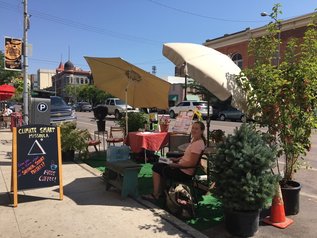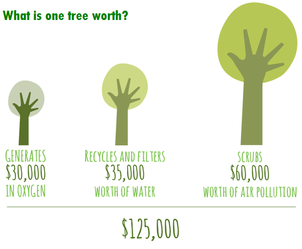 Based on my several sunburn patches and the delightful smell of sunscreen on all my clothes, it appears that summer is FINALLY here! Now that the warmer weather seems to be sticking around, it’s getting easier to wrap our heads around things like wildfire smoke, shade, and trees. You may have even seen us on the river trail during the last couple weeks working on the construction of our first shade shelter, part of our Summer Smart initiative. This past week, our Monthly Meetup was all about urban trees, wildland forests, and why they are so important to the climate conversation. Our urban and wildland forestry bucket encompasses quite a range of goals and strategies around the how’s and why’s of strengthening and managing urban, wildland forests and open lands. Urban forests are an important part of smart growth and climate mitigation, providing value, beauty, and physical and mental health benefits to the community. Smart management of wildland forests is vital for mitigating the effects of fire, wildlife stressors, and maintaining a safe wildland-urban interface (WUI). Clearly the nexus of climate change and trees is strong. Our conversation on Thursday was a great chance to talk with local experts and interested individuals about what work needs to be done, should be done, and what Climate Smart Missoula’s role should be.  As we learned from our friend Karen Sippy, executive director of Trees For Missoula, the value of healthy urban forests is much more than you might think (see the value of one tree in the image at right). Trees help scrub air pollution, store carbon, keep our homes and communities cooler, and even reduce storm water runoff, in addition to adding monetary value to your property. Quite the list of benefits! Thanks to Missoula's Urban Tree Census that will be updated next year, we know there are about 30,000 trees within city limits, and that’s just on public/city-owned lands. 27,000 of these trees have been inventoried by certified arborists and valued at $91 million. Unfortunately, we also know that most of the trees making up our urban forests are nearing the end of their life span. More about that from a recent Missoula Current article. The City of Missoula adopted an Urban Forest Master Plan in April 2015 with the goal of developing a healthy, vibrant and sustainable urban forest we can continue to enjoy. Because climate change brings with it more regular heat events and increased risk of disease and pest infestation, it will be important to think carefully about the trees we plant for the future and how we care for them. We know disease spread is best prevented by strategic variety in trees to create disconnected systems. Check out the City’s list of Approved Street Trees to see what trees are best suited for Missoula’s boulevards and public spaces. And Climate Smart has information about the best trees and shrubs for homeowners. Also see our 2016 Tree Canopy Assessment for the Missoula community. And remember, during the typical arid summers of western Montana, it's critical to water your shade trees. They need a deep drink once a week or so to stay healthy. Pruning matters too. Find more tips at Trees for Missoula. Some important questions we discussed: How do we better incorporate trees into planning and new developments? The most effective way to ensure trees are included in the planning and development process is to have strong policies for developers, particularly when it comes to required landscape features. Our current growth policy supports this! Presently Missoula is developing new "Design Standards" to guide our future, and this provides a perfect opportunity to weigh in and bring urban trees and green infrastructure forward as priority. Head HERE and comment. Trees are clearly important to have on your property for a lot of reasons, but what about the problems shade creates for rooftop solar potential? Having trees on your property is important for our overall tree canopy health as well as improving the comfort and value of your home. Sometimes this means rooftop solar does not fit on a home. This is a big reason we at Climate Smart support changing state legislation to allow for community solar projects. See our advocacy page for more info. How can we make it so people who need trees can get them? Are there options or programs in place for new home buyers or low income families to plant [the right] trees? Trees have many social, mental, and physical health benefits but they can also be expensive. We're presently working to develop programs to help with this, as there is nothing substantial happening today. The Missoula City-County Health Department has been working on some interactive Health Maps that could help in identify what areas need trees the most. Have ideas? Let us know! What about native plants? Why are there non-native trees on the Boulevard & Parks Street Trees list? Unfortunately, if we only stuck to native trees in our boulevards, we would end up with something of a monoculture, which is not ideal for disease and pest prevention. The list of Approved Street Trees was created to include trees that can survive and be more easily maintained in public spaces. However planting and caring for native trees is much easier in your own yard! Wildland Forest
Clearly, urban forestry is an important piece to building a healthy and resilient community. Just as with our urban forests, it's vital that we also take a mindful approach to managing wildland forests. 60 minutes recently did a segment about this issue. Missoula and surrounding communities all have examples of development taking place in the WUI putting homes at a greater risk from wildfires. With more frequent, longer, and hotter fires every year, the idea of “living with fire” is more important than ever. Especially for homes in the WUI, it is important to understand best practices for keeping your home (and the firefighters who protect it) safe. We have great resources on our Active Fires website.
1 Comment
|
AuthorsAbby Huseth Archives
July 2024
Categories
All
|


 RSS Feed
RSS Feed


